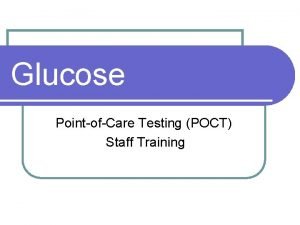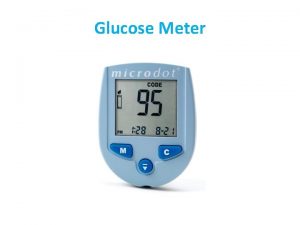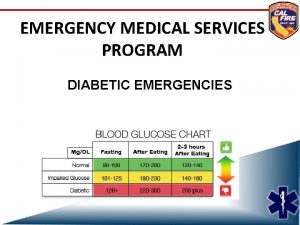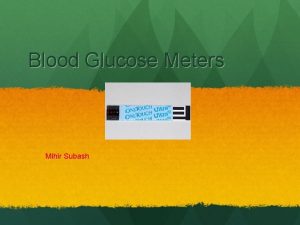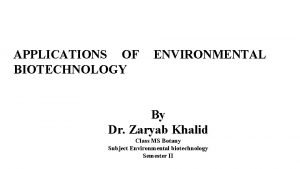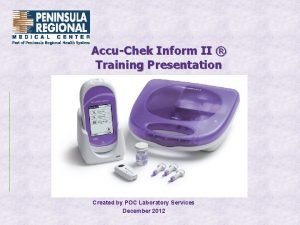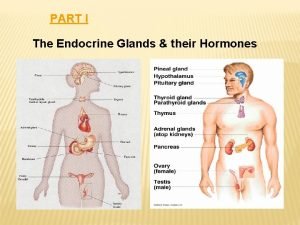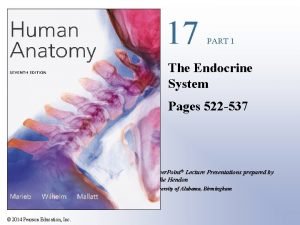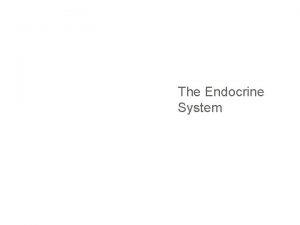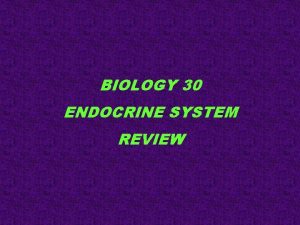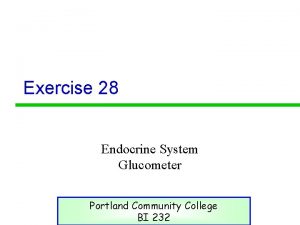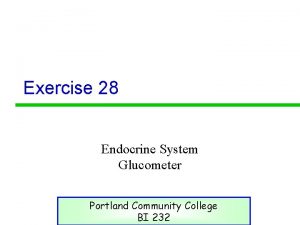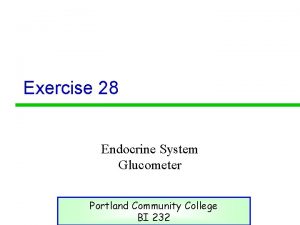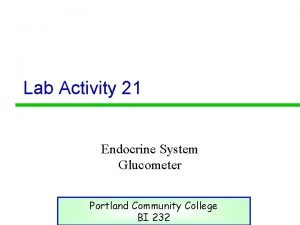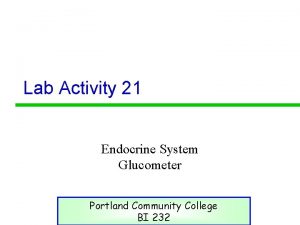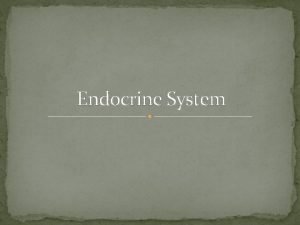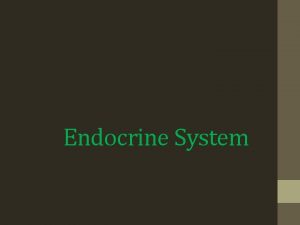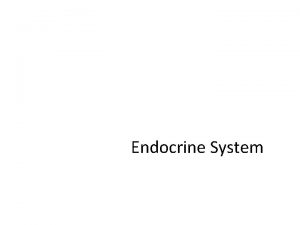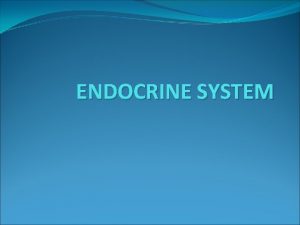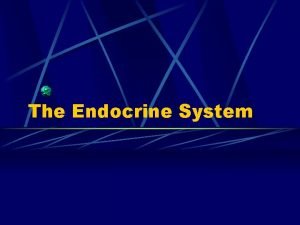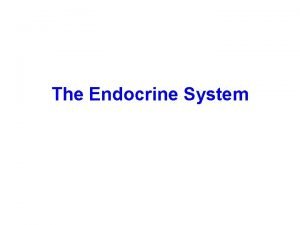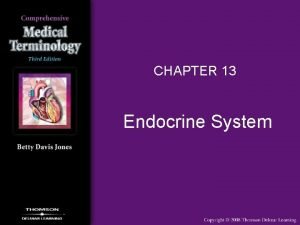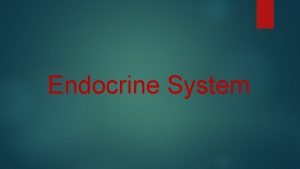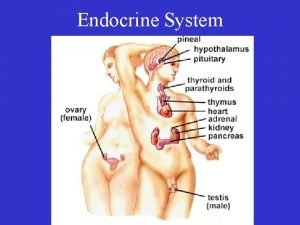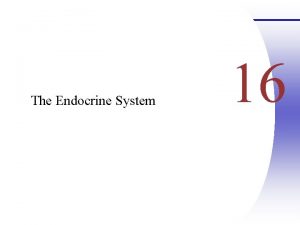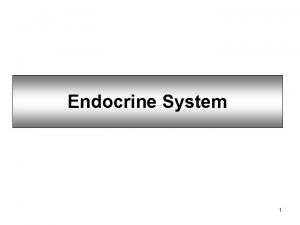Exercise 18 Endocrine System Glucometer Portland Community College































- Slides: 31

Exercise 18 Endocrine System Glucometer Portland Community College BI 232

The endocrine system • Diverse collection of organs and tissues that contain endocrine glands. • Glands secrete chemicals called hormones into blood capillaries • Hormones are transported to target cells at a distant location • Hormone binds to a specific receptor and the cell responds to message. 2

Endocrine and Exocrine • Exocrine glands secrete substances into ducts, which transport the secretions internal cavities of organs or to surface of the skin. 3

Neuroendocrine effect • The endocrine system operates in conjunction with the nervous system to maintain homeostasis and to ensure that bodily functions are carried out efficiently. • Nerve impulses can affect the release of hormones and hormones can regulate nerve impulses 4

5

Endocrine Organs in Head • Pineal gland Secrets: • Melatonin • Involved in circadian rhythms • Day melatonin, Night melatonin • Produces sleepiness 6

Endocrine Organs in Head • Hypothalamus produces a number of releasing hormones and inhibiting hormones. • Stored in posterior pituitary • • ADH (antidiuretic hormone) • Reduces urine output by increasing water reabsorption in the kidney • Plays small role in blood pressure regulation Oxytocin • Causes uterine contractions in labor • Causes milk let down in lactating mothers 7

Endocrine Organs in Head • • Hypophysis ACTH (adrenocorticotropic hormone) • Regulates the activity of the cortex of the adrenal gland TSH (thyroid stimulating hormone) • Stimulates production and release of thyroid hormone GH (growth hormone) • Stimulates growth of bones, cartilage, muscle • Timing and amount released determines body size 8

Endocrine Organs in Head • • • PRL (prolactin) • Stimulates breast development • Promotes and maintains lactation after childbirth FSH (follicle stimulating hormone) • Causes formation of ovarian follicles and stimulates them to produce estrogen • Stimulates sperm development in men LH (luteinizing hormone) • Initiates ovulation, maintains corpus luteum • Regulates testosterone production in males 9

Pituitary Histology 10

Endocrine Organs in Neck • Thyroid gland secretes: • Thyroid Hormone • Regulates metabolic rate of the entire body • Important in development of the nervous system • • Calcitonin • Decreases bone reabsorption, lowering serum calcium levels PTH (parathyroid hormone) • Increases serum calcium • Decreases serum phosphorus 11

Thyroid Histology 12

Thyroid Histology • Follicular cells produce the colloid (contains precursors to thyroid hormone) • Parafollicular cells secrete calcitonin 13

Parathyroid Histology 14

Endocrine organs in thoracic • Heart: If blood volume is elevated above normal, cardiac muscle cells in the heart was secrete natriuretic peptides. • Act on the kidneys to promote the loss of sodium ions and water. • The thymus gland produces hormones called thymosins that promote maturation of Tlymphocytes that coordinate the body’s immune response. 15

Endocrine Organs located in abdominopelvic cavity • • • Pancreas secretes: Insulin • Released in response to high blood sugar • Increases cellular absorption of glucose • Increases rate of lipogenesis and formation of glycogen in the liver Glucagon • Released in response to low blood sugar • Elevates blood glucose levels by promoting the breakdown of glycogen. 16

Pancreas • Acinar cells secrete digestive enzymes (exocrine) • Islet cells secrete insulin (beta cells) and glucagon (alpha cells) 17

Adrenal Glands 18

Endocrine Organs located in abdominopelvic cavity • • • Adrenal glands secrete: Glucocorticoids (Cortisone) • Released in response to stress • Increases formation of glucose from protein and fat breakdown • Decreases inflammation Aldosterone • Increases blood volume by causing kidneys to retain sodium (where sodium goes water goes too) in exchange for potassium • Increased blood volume will increase blood pressure 19

Endocrine Organs located in abdominopelvic cavity • Androgens • Are male sex hormones that are produced in small quantities and converted to estrogens (female sex hormones) when they enter the blood • Epinephrine & Norepinephrine • Fight or flight response • Increase heart rate, increase skeletal muscle blood flow, decrease skin blood flow 20

Hormones from the Kidneys • Erythropoietin • Stimulates RBC production • Calcitriol • Stimulates calcium and phosphate absorption • Stimulates calcium release from bone • Inhibits PTH secretion 21

Adrenal Histology 22

Adrenal Cortex Zona Reticularis: Androgens Zona Fasiculata: Glucocorticoids (Cortisone) Zona Glomerulosa: Aldosterone 23

Gonads • Ovaries in females produce estrogens • Testes in males produce testosterone 24

Ovary • Have an outer cortex that contains ovarian follicles at various stages of development. • Each follicle contains a developing egg cell called an oocyte • Inner medulla is a region of loose connective tissue 25

Testis • Tunica albuginea is a fibrous connective tissue covering. • Connective tissue partitions derived from the tunica albuginea divide the testes into lobules 26

Testes • Each lobule of the testes are three or four seminiferous tubules. • Collectively these cells are called spermatogenic cells. • The interstitial areas contain the interstitial (Leydig) cells. 27

Diabetes • • Type 1: Insulin Dependent Diabetes AKA: juvenile diabetes Caused by a lack of insulin Autoimmune disorder • Immune system destroys beta cells in the pancreas 28

Diabetes • Type 2: Non-Insulin Dependent • Caused by an insensitivity of cells to insulin. • Diabetes mellitus marked by hyperglycemia • urine production (polyuria) • thirst (polydipsia) • eating (polyphagia) 29

Diagnosing Diabetes Mellitus • Normal blood glucose levels: 70 -100 mg/dl • Diabetes mellitus: • A fasting glucose level above 140 mg/dl on two separate occasions, or • A blood sugar over 200 mg/dl 2 hours after oral glucose tolerance test with 75 gm of glucose • Impaired Glucose Tolerance (Pre-Diabetes) • A fasting glucose level between 100 -126 mg/dl on two separate occasions, or • A blood sugar between 140 -200 mg/dl 2 hours after oral glucose tolerance test with 75 gm of glucose 30

The End 31
 Endocrine system and reproductive system
Endocrine system and reproductive system Endocrine system vs nervous system
Endocrine system vs nervous system Lympathic
Lympathic General mechanism of hormone action
General mechanism of hormone action Adh function
Adh function Truetrack glucometer
Truetrack glucometer Glucometer use
Glucometer use Estimation of glucose by god pod method procedure
Estimation of glucose by god pod method procedure Glucometer use
Glucometer use Glucometer use
Glucometer use Glucometer
Glucometer Glucometer block diagram
Glucometer block diagram Glucometer use
Glucometer use Glucometer
Glucometer Glucometer
Glucometer Accu chek inform ii glucometer
Accu chek inform ii glucometer Chapter 16 matching questions 6-10
Chapter 16 matching questions 6-10 Parts of the endocrine system
Parts of the endocrine system The body's speedy electrochemical communication network
The body's speedy electrochemical communication network Comparison of endocrine and nervous system
Comparison of endocrine and nervous system Endocrine molecules
Endocrine molecules Facts about the endocrine system
Facts about the endocrine system Diaphragm of rat
Diaphragm of rat Calcitonin and pth are antagonistic hormones
Calcitonin and pth are antagonistic hormones Humoral neural and hormonal stimuli
Humoral neural and hormonal stimuli Are endocrine glands ductless
Are endocrine glands ductless 7:13 endocrine system
7:13 endocrine system Mammillary body
Mammillary body Stimulus humoral
Stimulus humoral Hypothal
Hypothal Biology 30 endocrine system
Biology 30 endocrine system Gonads glands
Gonads glands










